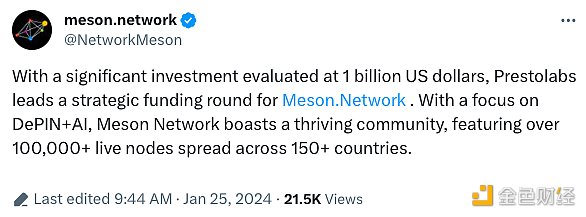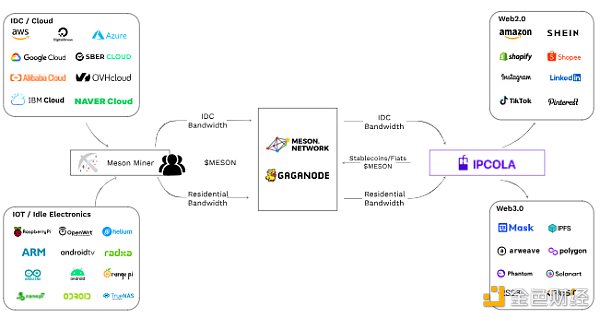Written by: 0xxz@金财经
On January 25, 2024, CoinList announced that it will conduct a community public sale of Meson token MSN on February 8.
At the same time, Meson Network officially announced the completion of the latest round of strategic financing, with a valuation reaching US$1 billion, making it one of the unicorns.

In addition, Meson Network The investor lineup is also very luxurious.

MSN community public sale Details
Sale time: 18:00 UTC on February 8, 2024
Supply: 2.5 million MSN tokens (2.5% of total supply)< /p>
Price: $1.75
Lock-up and release: One-sixth will be unlocked around March 15, 2024, and the remaining tokens will be unlocked monthly within 6 months
Initial purchase limit: minimum $50, maximum $3,000 (USDT/USDC only)
Note: Meson may sell an additional 2.5 million MSN tokens during the community public sale at its sole discretion .
What is Meson Network
The goal of Meson Network is to create an efficient bandwidth market on Web3, use the blockchain protocol model to replace the traditional manual-based sales model, and integrate long-term sales at low cost. Tail users’ idle bandwidth and monetize it.
Meson Network initially focused on the decentralized CDN (content distribution network) market, and later gradually expanded its service scope to computing, In areas such as AI, the new goal is even more ambitious, becoming the basis for decentralized storage, computing and data transmission in the emerging Web3 Dapp ecosystem, and being supported by fashionable new concepts such as DePIN+AI.
Meson Network nodes are developed using user-friendly technology and can accommodate various hardware such as personal laptops, servers, and IoT devices. Utilizing the idle bandwidth of these network nodes, Meson establishes an economic cycle that connects idle resources with business needs.
Meson Network working mechanism
Meson Network architecture mainly consists of three parts:

CDN & GatewayX: IDC or cloud idle IP and bandwidth market
GagaNode: Personal Idle IP and bandwidth market
IPCola: Gather the above resources and match them to industries in need, such as Web3 applications, AI, and even reverse provision to Web2 applications

Meson’s goal is to create the world’s largest bandwidth market. Users provide unused bandwidth resources to Meson in exchange for tokens, and those in need of bandwidth go to the Meson market to borrow bandwidth from anywhere in the world.
Existing cloud providers rely more on a sales model, a top-down model to aggregate resources. For example, if you want to open a new local market, you need to recruit local people, and as the market coverage expands, the number of people recruited will increase linearly or even exponentially. This model has been very effective over the past 10 to 20 years because this sales model has led to targeting medium to large customers, which can provide high output per customer. But the current situation is that many resources are slowly dispersed into the long-tail market where demand is more dispersed, resulting in a significant reduction in the output of each account. However, demand growth is stronger in the long-tail market than in the large-account market. In order to capture long-tail market demand, a new alternative to the direct sales model is needed.
The answer is open bandwidth switching, done through Meson Network. Meson integrates resources from the bottom up. Users do not need to care about how to deal with people, they only need to upload or access resources on the market in accordance with standards and protocols. The advantage of this new model is to eliminate human interaction in the system as much as possible and achieve rapid scale through free market mechanisms.
Current status of Meson Network
According to official data, Meson Network currently has more than 130,000 nodes (110,000 GagaNode and 27,000 GatewayX IDC nodes), which can provide innovative decentralization across different industries. It has laid the foundation for globalization, including CDN, AI, social media, advertising technology, e-commerce, finance, etc.

GatewayX IDC node The bandwidth capacity reaches 17.8Tb/s.

 Catherine
Catherine












